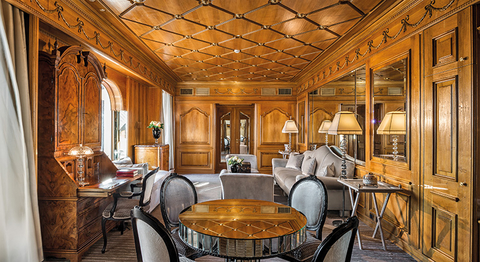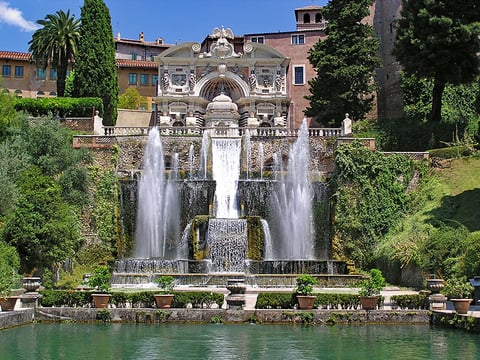Let’s begin with the classics, in this 2,771st year since Rome was founded. The largest exhibition of Canaletto works ever held in Italy opened in April and will continue until August 19, 2018, at the Museo di Roma at Palazzo Braschi. This is a must-see for art lovers. The exhibit commemorates 250 years since the death of Canaletto (1697-1768), the Venetian painter who brought landscape painting to the highest level.
Even more classically Roman are the outdoor summer performances at the Baths of Caracalla. Under the stars, umbrella pines silhouetted in the shadows, and a glowing stage set amid the ancient ruins: it doesn’t get more Roman than that. The season runs from June 13 to August 6, 2018. Highlights include a new production of the opera, “La Traviata,” along with the world premiere of a new adaptation of the ballet “Romeo and Juliet.” For those who prefer a more private experience, the boutique hotel Pepoli 9 offers two suites that overlook the Baths.
The Vatican Museums are now free on the last Sunday of every month between 9 a.m. and 12:30 p.m., with closing at 4 p.m. (Sunday is normally a closing day for the Vatican Museums.) Tickets cannot be reserved, but must be picked up on the day of the visit at the museum ticket office. The museum is closed if a holiday falls on a Sunday, such as Easter, as well as on the Feast of Saints Peter and Paul (June 29), Christmas and December 26. Expect crowds during peak seasons.
On the digital side, history is brought to life with outdoor spectacles at the Forum of Caesar and Forum of Augustus nightly now through November 11. The Italians are especially good at presentations that employ music, light projections and historic commentary to portray life in ancient Rome. Using the ancient ruins as the focus, the shows use technology to reconstruct the forum as it was in the time of the Caesars. In addition, visitors to the Baths of Caracalla may see the ancient complex re-created using 3D technology and virtual reality. The virtual reality tour at the Baths will be available until December 31, 2019.

On the accommodations front, the venerable Hassler Roma, which stands at the top of the Spanish Steps, celebrates 125 years as a Grand Dame hostelry in 2018. After a three-week closure in January, Hassler Roma unveiled its updated Presidential Suite San Pietro, along with renovations to its other suites (which now total 21), guestrooms and public spaces. Clients seeking something new can opt for two boutique hotels, Margutta 19 (a member of Small Luxury Hotels of the World) and Hotel Vilòn, which opened in late 2017 and early 2018, respectively, in the historic city center. The two-year-old Fendi Private Suites hotel has been refreshed, while downstairs in the Fendi flagship store the new design season is under way, tempting guests to pay a visit. Just last fall, Hotel de Russie, a Rocco Forte Hotel unveiled the newly renovated Nijinsky Suite. Perched on the top floor and encompassing 1,850 square feet, this suite affords views of the Eternal City and Villa Borghese gardens from its furnished terrace.
Italian hair stylists are known for their way of taking the most mundane hairdo and making it sophisticated and au courant. Jill Cento’s tiny Elements Salon off the elegant Via Giulia gives an Italian experience in English, the best of both worlds. Vatami, a boutique hairstylist, on Viale Aventino, uses organic products to revitalize a weary traveler’s locks. Let it be also said that the Roman water, coming from deep underground, makes for lush, full hair.
Rome means shopping, as well as sightseeing. A favorite among locals (especially top models and fashionistas) is Le Velvet di Eva Camilli on Via del Governo Vecchio. It sells handmade, elegantly crafted earrings, necklaces and clutches, the ultimate souvenirs for a trip to Rome. For your male clients, there is Wools Boutique Uomo, also on Via del Governo Vecchio, where men’s high-end brands and a selection of hand-made seven-fold ties are available. Roi du Lac, a home decor and ready-to-wear showroom in Piazza de’Massimi is enticing on so many levels, including color, design and selection.
The Eternal City is known for having fine restaurants within hotels — well-known chefs partner with hotels to deal with the exorbitant cost of real estate. With locations around the world, the gourmet Japanese restaurant Zuma has a great location on the top floor of the Palazzo Fendi. The lunch specials are varied and affordable and the rooftop bar is attractive. Le Colbert, upstairs at Academie de France Villa Medici, offers snacks and meals with a view across the historic city. (There is no elevator and no cloakroom, so don’t take heavy bags). Retrobottega is intimate, somewhat self-service and open all day. It doesn’t take reservations, but the food is fresh and interesting.
Party animals should take note of a new police rule in Rome. Popular areas of nightlife are now under permanent anti-alcohol and anti-glass prohibitions. From 11 p.m. on, it is illegal to consume alcohol or other drinks from glass containers on the streets, and after 2 a.m. these may no longer be served. Offenders in these zones may be removed from the area for a certain length of time.
Day Trips From Rome

For repeat visitors, in particular, suggest day trips outside of Rome. The Castelli Romani area southeast of the city is known for its white wines and charming ambiance. (Rome is the only European capital located in a Premier Grand Cru wine area). Consisting of several hill towns, the Castelli includes Frascati, where Romans go for cool weather and refreshment in the summer. Tivoli is another favorite spot, though in summer it’s best to go early. The two primary attractions in Tivoli are the Villa d’Este, with its sumptuous gardens; and the expansive park and ruins of Hadrian’s Villa. The Ristorante Sibilla overlooks the town from a terrace studded with ancient Roman columns. Ostia Antica is another daytrip destination from Rome, where the city’s original harbor is now a restored outdoor museum. Nearby, in the coastal town of Fiumicino, are dozens of restaurants offering freshly caught seafood specialities. All of these places can be reached by public transportation.
A little further south is Sabaudia, where Romans escape the city heat to hit the beaches. Built on reclaimed marshland, Sabaudia is near the site of where Ulysses met Circe on the beach below Monte Circeo. The boutique hotel San Francesco edges a lake where rowing races and sailing are popular. The hotel also has its own Mediterranean beach reserved for guests. Up on the mountain, the charming little town of San Felice Circeo is full of boutiques and cobbled streets.
Rumored for years as the site of a future Rome airport, the town of Viterbo is a quick train trip north from the city. The layers of history in Viterbo range from the Etruscans to the seat of the popes. In addition, there are ancient thermal baths to enjoy. An itinerary focused on the history of Etruscans could begin with the Villa Giulia, the important Etruscan museum in Rome, and continue in the towns and necropoli in Viterbo and surroundings. Netflix subscribers familiar with the British-Italian television series “Medici: Masters of Florence” may note that it was filmed in part in the medieval section of Viterbo, which stood in for 15th-century Rome.
Spa resorts and hotels, such as the Terme dei Papi and Terme Salus, are built around the natural hot springs in the Viterbo area. Visitors can dip into pools of varying temperatures, as well as indulge in full spa treatments.
After a few days spent sightseeing among the crowds in Rome, these side trips can add a relaxing and engaging element to a city-based itinerary.
Related Stories
Intrepid Travel Debuts Vegan Tours
A Dare: Skip the Colosseum and Vatican on a Trip to Rome?
Searching for the Soul of Florence – the Travel Secrets of a Local
Italian Capitals of Culture Travel Guide: Matera, Palermo and Parma